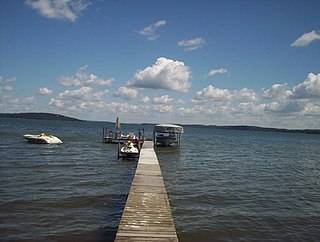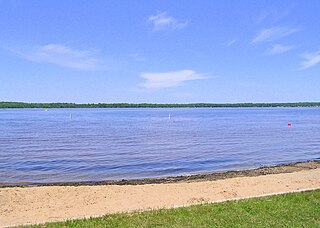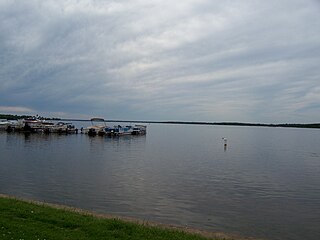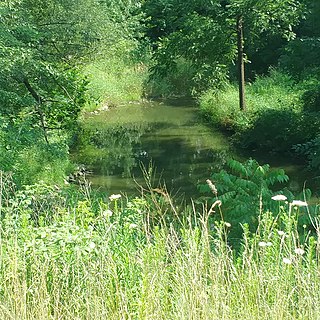
Muskego is a city in Waukesha County, Wisconsin, United States. As of the 2020 census, the city had a population of 25,032. Muskego is the fifth largest community in Waukesha County, Wisconsin. Muskego has a large Norwegian population. The name Muskego is derived from the Potawatomi Indian name for the area, "Mus-kee-Guaac", meaning sunfish. The Potawatomi were the original inhabitants of Muskego. There are three lakes within the city's boundaries.
Lake Koshkonong is a naturally occurring lake that acts as a reservoir in southern Wisconsin. Its size was augmented by the creation of the Indianford Dam in 1932, making it one of the larger lakes in the state. The lake lies along the Rock River, with the river acting as both the primary inflow and the primary outflow for the lake. Lake Koshkonong begins 5.5 mi (8.9 km) downriver from Fort Atkinson, with the large majority of the lake located in southwestern Jefferson County. Small portions of the lake extend into southeastern Dane and northern Rock counties.

Lake Mendota is a freshwater eutrophic lake that is the northernmost and largest of the four lakes in Madison, Wisconsin. The lake borders Madison on the north, east, and south, Middleton on the west, Shorewood Hills on the southwest, Maple Bluff on the northeast, and Westport on the northwest. Lake Mendota acquired its present name in 1849 following a proposal by a surveyor named Frank Hudson, who claimed to be familiar with local Native American languages; Lyman C. Draper, the first corresponding secretary of the Wisconsin Historical Society, proposed that 'Mendota' could have been a Chippewa word meaning 'large' or 'great.'

Big Lake Butte des Morts is a shallow freshwater lake located in the U.S. state of Wisconsin, in Winnebago County. It is part of the Winnebago Pool of lakes in east central Wisconsin, along with Lake Winnebago, Lake Poygan, and Lake Winneconne. The lake is fed by the Fox River in the southwest and the Wolf River draining from Lake Winneconne in the northwest, and drains via the Fox River southeast into Lake Winnebago. The lake is part of the Butte des Morts region in Winnebago County, Wisconsin. This lake is not connected to Little Lake Butte des Morts, which is located to the north, downstream of Lake Winnebago, fed by the lower Fox River.

Green Lake — also known as Big Green Lake — is a lake in Green Lake County, Wisconsin, United States. Green Lake has a maximum depth of 237 ft (72 m), making it the deepest natural inland lake in Wisconsin and the second largest by volume. The lake covers 29.72 km2 and has an average depth of 30.48 m (100.0 ft). Green Lake has 43.94 km (27.30 mi) of diverse shoreline, ranging from sandstone bluffs to marshes.

Lake Noquebay is a large freshwater lake in northeastern Wisconsin. It is the largest lake in Marinette County. It is located north of Green Bay, Wisconsin, approximately 4 miles (6.4 km) northeast of Crivitz, Wisconsin.

Lake Minocqua is a freshwater natural drainage lake in northern Oneida County, Wisconsin. It is 1360 acres (5.5 km²) in area, with an average depth of 23 feet (7 m) and a maximum depth of 60 feet (18.3 m).

Shawano Lake is a lake situated in Shawano County in northeastern Wisconsin. Shawano Lake is a hard water drainage lake with multiple inlets and one major outlet, the Wolf River. A dam on the Wolf River located in the City of Shawano raises the water levels of Shawano Lake. Shawano Lake is approximately 6,178 acres (25.00 km2), with an average depth of approximately 9 feet (2.7 m) and a maximum depth of approximately 42 feet (13 m). The shoreline length is estimated at 18 miles (29 km). The Towns of Wescott, and Washington, and the Village of Cecil border Shawano Lake.

Castle Rock Lake is an artificial lake on the Wisconsin River. It is located in central Wisconsin in Adams County and Juneau County. The lake has an inflow from Petenwell Lake, Yellow River, Big Roche a Cri., and Klien Creek. It has a surface area of 16,640 acres (67.3 km2) and its depth varies from 8–20 ft (2.4–6.1 m) in most places, with area in the old river beds reaching as deep as 35 ft (11 m).

Trout Lake is in Vilas County, Wisconsin, near the towns of Boulder Junction and Arbor Vitae, Wisconsin. With a surface area of 6.208 sq mi (16.079 km2) and a volume of 0.058 cu mi (0.240 km3), Trout Lake is one of the largest lakes in Vilas County. It has 16.1 mi (25.9 km) of shoreline, a large portion of which is undeveloped. There are also seven islands within the lake: Miller Island, Zimmerman Island, Haunted Island, Easter Island, Fisk Island, Chocolate Drop Island, and an unnamed island. It is a dimictic oligotrophic lake that supports a large number of sport fish, which has made it a popular angling destination.

The Turtle-Flambeau Flowage is a 12,942 acres (52.37 km2) lake in Iron County, Wisconsin. It has a maximum depth of 15 meters and is the seventh largest lake in the state of Wisconsin by surface area. The flowage is home to unique wetland patterns and plant species as well as several species of sport and game fish, including Musky, Panfish, Largemouth Bass, Smallmouth Bass, Northern Pike, Walleye and Sturgeon. The lake's water clarity is low, but can vary in different locations in the lake. Fishing, camping, boating, and hunting are popular activities on the flowage, and Ojibwe people traditionally harvest fish and game on the lake. Environmental concerns on the flowage include mercury contamination, algal blooms, and several types of invasive species.
Crystal Lake is one of at least 22 lakes of that name in the state of Wisconsin. It has a surface area of about 93 acres, and is located just south of Big Muskellunge Lake, in Vilas County in the Northern Highland region of Wisconsin. The nearest community is Sayner, about 5 miles to the east. Visitors have access to the lake from a public boat landing, public beaches and the Northern Highland-American Legion State Forest. Fish include panfish, largemouth bass, and trout.
Little Dummy Lake is a lake in Barron County, Wisconsin, in the United States.

The Southern Unit of the Kettle Moraine State Forest includes more than 22,000 acres of land throughout southern Wisconsin and spans several state parks and natural areas. The area also features varied environments from restored prairie, forests, and lakes, along with providing a multitude of recreational opportunities such as hiking, birdwatching, fishing, camping, and hunting. The Kettle Moraine Scenic Drive also extends within this region as well as through a larger portion of the state.
Fox Lake is a 2,713 acre lake in Dodge County, Wisconsin. The City of Fox Lake, and the communities of Lyndon Dale and Delbern Acres are found along the shoreline. There are two boat landings that are open to the public, found in parks on the northwest and southeast sides of the lake. Fish present in the lake are Panfish, Muskellunge, Largemouth Bass, Northern Pike, and Walleye. Fox Lake is split by the peninsula, that the community of Lyndon Dale is located on, in the south end of the lake. This forms a bay known as The Jug, near the City of Fox Lake. According to the DNR, the bottom of the lake is 1% sand, 30% gravel, and 69% muck. The lake goes through the Fox Lake Dam, into Mill Creek, then flows to Beaver Dam Lake. The Fox Lake Correctional Institution is less than a mile from the north shore of the lake.
Pine lake is a deep seepage lake near the community of Springwater, Wisconsin, in Waushara County, located in central Wisconsin. It is one of eight lakes that can be found in the township of Springwater. This lake is 137 acres with a 48-foot maximum depth. It is a popular attraction for both fisherman and boaters.

Puckaway Lake also referred to as Lake Puckaway is a lake in Green Lake County and Marquette County, Wisconsin. The lake has a surface area of 5,013 acres (20.29 km2) and a max depth of 5 ft (1.5 m). Most of the lake has a muck bottom and is shallow with an average depth of 3 ft (0.91 m).

Jewel Creek is a stream in Muskego, Wisconsin. It flows from Linnie Lac to Little Muskego Lake, and is the primary tributary of Little Muskego Lake. Despite its relative proximity to Lake Michigan, Jewel Creek is part of the Mississippi River Watershed. Jewel Creek has a drainage area of 8.16 square miles. Between the years 2000 and 2003, its average flow rate was 6.52 cubic feet per second.
Cravath Lake is a freshwater lake located near the center of Whitewater, Wisconsin.














